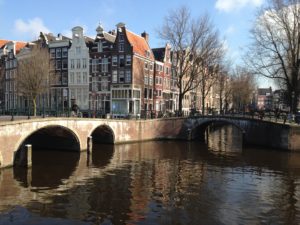I wouldn’t think of plagiarizing the photo that sets the tone for Russell Shorto’s mouthwatering New York Times article, “Amsterdam Revisited.” But I wish I could: it’s taken at my favorite time of day, twilight, just as the lamps are lit, with the last glow of northern light gracing the venerable canalhouses and a boxy modern houseboat, just like our 2009 Amsterdam home. Shorto’s history with Amsterdam is much deeper and longer than mine, and I always relish reading anything he writes. Amsterdam: A History of the World’s Most Liberal City is among my “must reads” for anyone who is about to visit.
As Shorto points out, it’s always the Golden Age in the central canals, where dreaming one’s way back to other centuries is just a matter of squinting a little, and focusing on the endless architectural details that distinguish the 1600s from other times. The edges of the stone outside staircases are just as rounded as the shape of the canals themselves. The ratio of window to brick seems inconceivable without the benefit of steel. It’s hard to believe that those miles of relatively untouched canal houses are all supported on wooden stakes sunk into the ground by manpower alone.

Amsterdam Canal Houses
Shorto moves beyond nostalgia skillfully, as he so often does, and touches on the paradox that the city is both the beneficiary and the victim of visitors from around the world, many of whom are not there to admire the architecture. I’ve been in Amsterdam from January to June on five occasions since 2001. The winter is best in every way. I even love the darkness, the long nights and the chilly, often rainy days. The city has a stillness at that time disturbed only on the weekend. As one wanders the canals, candles are often lit even in the middle of the day in the cafés and restaurants, and early in the evening in private homes. The gentle streetlights give an almost ethereal glow to the sidewalks and houses.
Spring Means Mobs
As tulip season approaches, it is as if human beings are poured out of some huge funnel and inserted in many streets in the center of the city. Spring also means weddings, and in the last few years, the displays of British stag and hen parties have bloated like tumors. Whole crowds of buddies invade, most with the goal of cramming as much debauchery and drinking as possible into a brief time. Once universities are out, the sidewalks are mobbed, and the lines at the Rijksmuseum and the Van Gogh require the patience of a tortoise. I’ve always gone home right about then.
Like Venice, Amsterdam could sink under the weight of all this.
Apart from all the visitors, there’s population pressure both from those born Dutch, and those who are entitled to immigrate from the former Dutch colonies which provided so much of the wealth of the Golden Age. Sheer numbers will change the character of a city that was only 734,000 when I first fell for it as if I were a teenager gawking at a movie idol. Then I began learning so much more about the city, and discovered one of its shadow sides: the Holocaust of almost three-quarters of the Dutch Jewish people, and how that could possibly happen in “the world’s most liberal city.” But that’s another story.
Kudos to Shorto for his tribute both to Amsterdam’s past, and a glimpse of the changes that already are and those which may be ahead.
